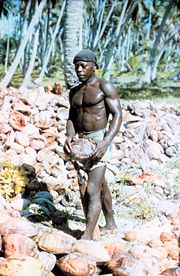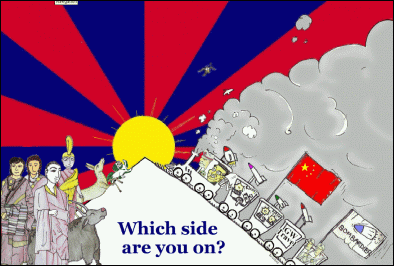Related post now added at Tibet protests . . . hope for Diego Garcians. . .?
Update from my previous post on this topic. See also Human Rights in China.
Update 1: The ugly reality (Ahmed Quraishi)
Pakistani foreign affairs commentator Ahmed Quraishi has argues that the Tibetan issue has been orchestrated by Washington to isolate China, especially in respect to Iran and oil-rich African nations. An article of his in Global Politician, Pakistan Beware, They Are Cornering China, makes some observations worth further exploration and debate. They partly support my own interpretations of what I have observed in news film footage over the last several weeks, that the evidence points to the real issue being racial conflict and the manipulation of this by external and/or sectional political interests:
. . . the ugly reality of what . . . . separatists have done during the Tibet riots. They burned five young waitresses alive in a restaurant. They snatched a young Chinese boy from his father, put him on the ground and then stomped on his chest and abdomen. An ethnic Tibetan doctor who tried to save the Chinese boy’s life was beaten by Dalai Lama’s insurgents. The Tibetan doctor is hospitalized in Lhasa, the Tibetan capital. The kid couldn’t make it. How about the infant who was burned alive in her parents’ apartment set on fire by the separatists? . . . .
And please don’t believe the U.S. propaganda depicting the riots as some kind of a Tibetan backlash against Chinese oppression. Lhasa, the Tibetan capital, is far ahead in modernization than India’s biggest northern cities across the border. This is the place where China spent a staggering U.S. $ 4.1 billion just to build the world’s highest rail track, a luxury service stretching 1,142km from Beijing to Lhasa. It’s part of an elaborate Chinese vision to ‘open up’ the country’s sparsely populated western regions and make them key to China’s growth in the 21st century.
The western focus now is to push the Chinese government to make one wrong move so that Washington and other ‘allied’ governments could drag Beijing into a costly confrontation. . . .
Update 2: Mythical images (Michael Parenti)
A lengthy article by Michael Parenti, Friendly Feudalism: — The Tibet Myth, examines the various political strains of Buddhism throughout Asia, pointing out that contrary to popular western images, not all Buddhists currently are or have been peaceful. Robert Pape’s Dying to Win documents Buddhists among other non-Islamic individuals being among the earliest and more numerous incidents of horrific violence among some sections of Buddhists.
Update 3: Democrats or feudal slave-owners? (Gary Wilson)
Gary Wilson looks at the history of the 1959 Tibetan uprising in Tibet and the March 10 commemoration of the CIA’s 1959 ‘uprising’. He argues that far from being a popular uprising it was more comparable to the Bay of Pigs fiasco where outside powers attempted to restore feudal rulers and slave owners who would back the right side in the Cold War.
Update 4: The financial and political backers of The International Campaign for Tibet (Soraya Sepahpour-Ulrich)
Iranian-American Soraya Sepahpour-Ulrich in The Tibet Card writes that the International Campaign for Tibet
receives grants from the National Endowment for Democracy – a State Department operation which engages non-suspecting NGOs to openly do what the CIA did/does.
Soraya adds
Neoconservative queen, Jean Kilpatrick was pushing The Committee of 100 for Tibet with artists such as Richard Gere as unsuspecting fronts.
and not to completely overlook a few other little goodies on the side . . .
Tibet has the world’s largest reserve of uranium, and in addition to gold and copper, large quantities of oil and gas were discovered in Qiangtang Basin in western China’s remote Tibet area. A friendly Dalai Lama would help reimburse the CIA subsidies, and much more.
Soraya’s main argument, however, is that the funding and political support for these protests are aimed at isolating China in particular from Iran.
With names like the National Endowment for Democracy and Jean Kilpatrick associated with the current protests over Tibet, anyone with any nous should surely think twice and ask for hard evidence of any claims and assertions being made by all sides before leaping in to the fray.
Yes the Chinese government is responsible for some of the most egregious human rights abuses that ought to be challenged. But we are not helping that cause by siding with the programs backed by the National Endowment for Democracy.
More on National Endowment for Democracy:
Trojan Horse (Blum)
Loose cannon (Conry/Cato)
Paying to make enemies (Paul)
Wikipedia
Like this:
Like Loading...


